TOYOTA GR86 2022 (in English) Service Manual
Manufacturer: TOYOTA, Model Year: 2022, Model line: GR86, Model: TOYOTA GR86 2022Pages: 582, PDF Size: 86.38 MB
Page 41 of 582
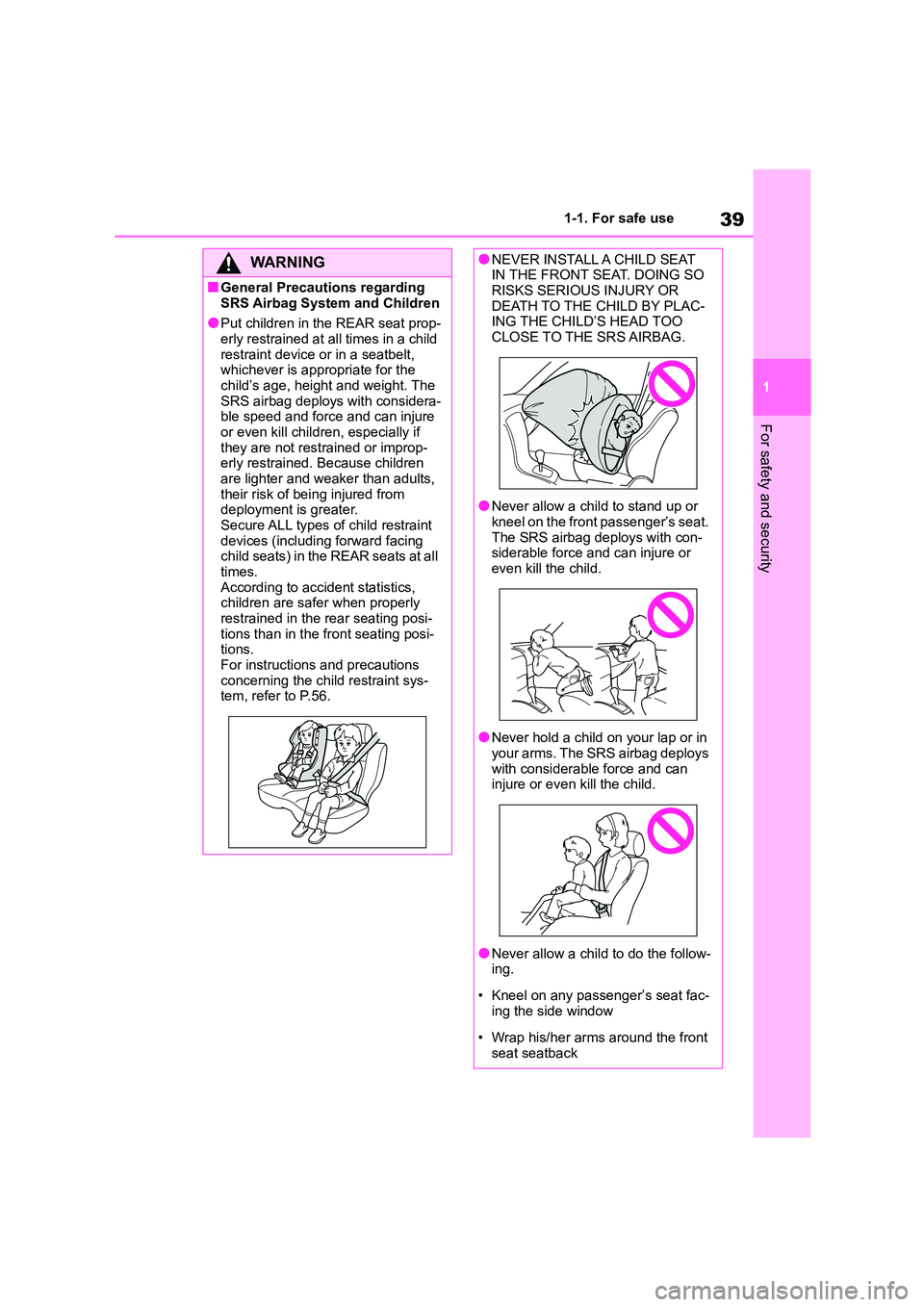
39
1
1-1. For safe use
For safety and security
WA R N I N G
■General Precautions regarding
SRS Airbag System and Children
●Put children in the REAR seat prop- erly restrained at all times in a child
restraint device or in a seatbelt,
whichever is appropriate for the child’s age, height and weight. The
SRS airbag deploys with considera-
ble speed and force and can injure
or even kill children, especially if they are not restrained or improp-
erly restrained. Because children
are lighter and weaker than adults, their risk of being injured from
deployment is greater.
Secure ALL types of child restraint devices (including forward facing
child seats) in the REAR seats at all
times. According to accident statistics,
children are safer when properly
restrained in the rear seating posi- tions than in the front seating posi-
tions.
For instructions and precautions concerning the child restraint sys-
tem, refer to P.56.
●NEVER INSTALL A CHILD SEAT IN THE FRONT SEAT. DOING SO
RISKS SERIOUS INJURY OR
DEATH TO THE CHILD BY PLAC- ING THE CHILD’S HEAD TOO
CLOSE TO THE SRS AIRBAG.
●Never allow a child to stand up or
kneel on the front passenger’s seat.
The SRS airbag deploys with con- siderable force and can injure or
even kill the child.
●Never hold a child on your lap or in
your arms. The SRS airbag deploys
with considerable force and can injure or even kill the child.
●Never allow a child to do the follow-ing.
• Kneel on any passenger’s seat fac-
ing the side window
• Wrap his/her arms around the front
seat seatback
Page 42 of 582
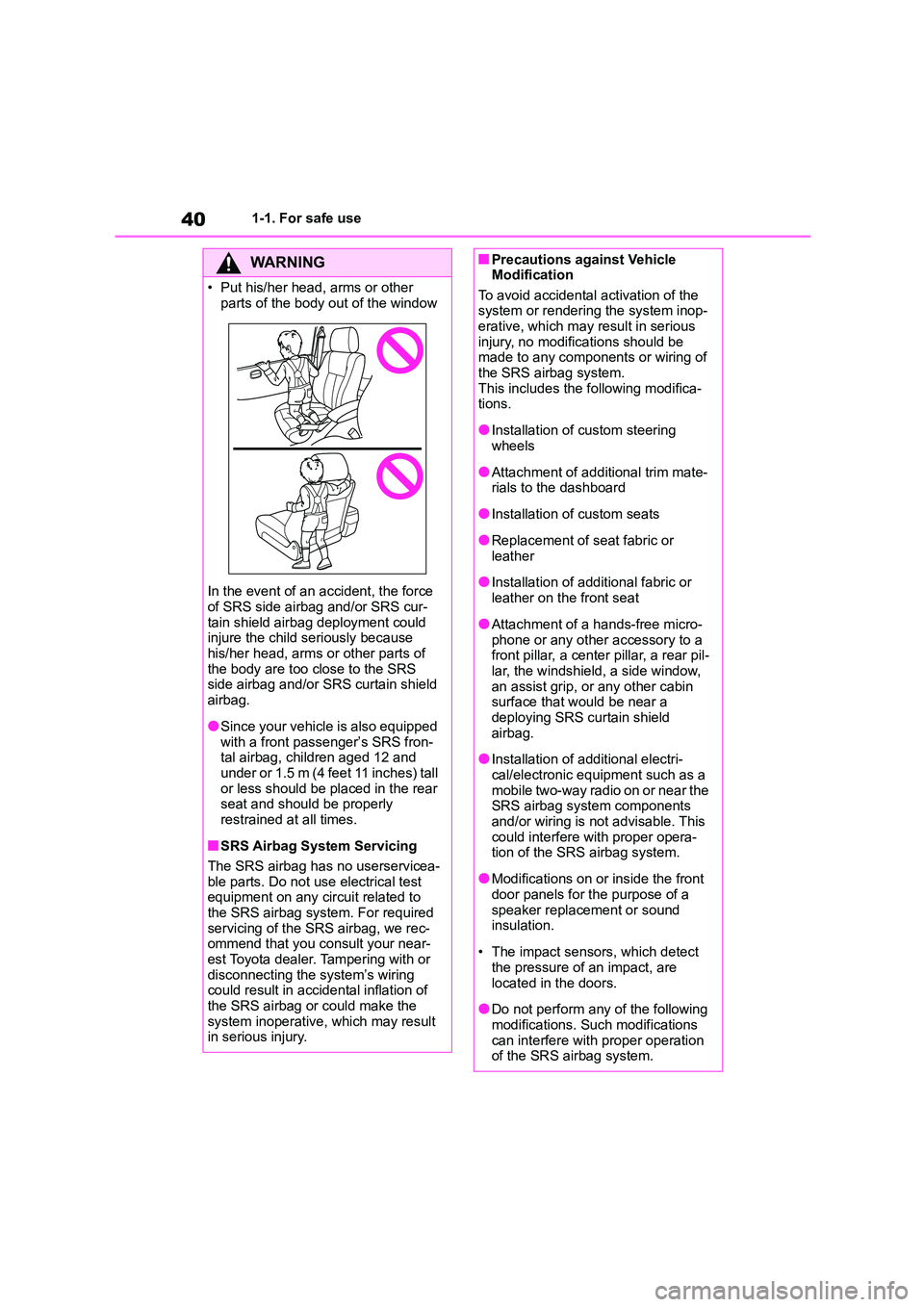
401-1. For safe use
WA R N I N G
• Put his/her head, arms or other
parts of the body out of the window
In the event of an accident, the force
of SRS side airbag and/or SRS cur-
tain shield airbag deployment could injure the child seriously because
his/her head, arms or other parts of
the body are too close to the SRS side airbag and/or SRS curtain shield
airbag.
●Since your vehicle is also equipped
with a front passenger’s SRS fron-
tal airbag, children aged 12 and under or 1.5 m (4 feet 11 inches) tall
or less should be placed in the rear
seat and should be properly restrained at all times.
■SRS Airbag System Servicing
The SRS airbag has no userservicea-
ble parts. Do not use electrical test
equipment on any circuit related to the SRS airbag system. For required
servicing of the SRS airbag, we rec-
ommend that you consult your near- est Toyota dealer. Tampering with or
disconnecting the system’s wiring
could result in accidental inflation of the SRS airbag or could make the
system inoperative, which may result
in serious injury.
■Precautions against Vehicle Modification
To avoid accidental activation of the
system or rendering the system inop- erative, which may result in serious
injury, no modifications should be
made to any components or wiring of the SRS airbag system.
This includes the following modifica-
tions.
●Installation of custom steering
wheels
●Attachment of additional trim mate-
rials to the dashboard
●Installation of custom seats
●Replacement of seat fabric or
leather
●Installation of additional fabric or
leather on the front seat
●Attachment of a hands-free micro-
phone or any other accessory to a
front pillar, a center pillar, a rear pil- lar, the windshield, a side window,
an assist grip, or any other cabin
surface that would be near a deploying SRS curtain shield
airbag.
●Installation of additional electri-
cal/electronic equipment such as a
mobile two-way radio on or near the SRS airbag system components
and/or wiring is not advisable. This
could interfere with proper opera- tion of the SRS airbag system.
●Modifications on or inside the front door panels for the purpose of a
speaker replacement or sound
insulation.
• The impact sensors, which detect
the pressure of an impact, are
located in the doors.
●Do not perform any of the following
modifications. Such modifications can interfere with proper operation
of the SRS airbag system.
Page 43 of 582
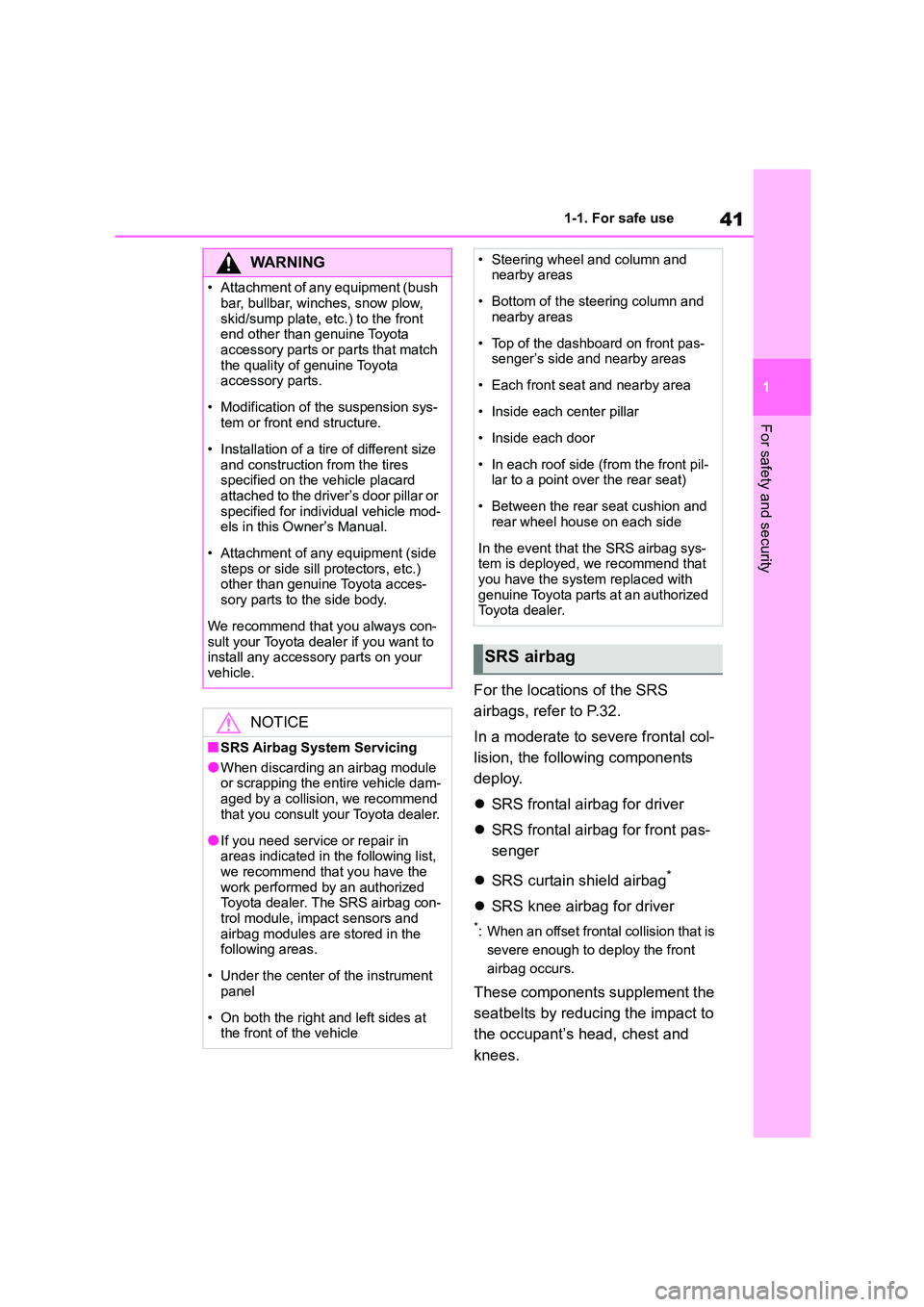
41
1
1-1. For safe use
For safety and security
For the locations of the SRS
airbags, refer to P.32.
In a moderate to severe frontal col-
lision, the following components
deploy.
SRS frontal airbag for driver
SRS frontal airbag for front pas-
senger
SRS curtain shield airbag*
SRS knee airbag for driver
*: When an offset frontal collision that is
severe enough to deploy the front
airbag occurs.
These components supplement the
seatbelts by reducin g the impact to
the occupant’s head, chest and
knees.
WA R N I N G
• Attachment of any equipment (bush
bar, bullbar, winches, snow plow,
skid/sump plate, etc.) to the front end other than genuine Toyota
accessory parts or parts that match
the quality of genuine Toyota accessory parts.
• Modification of the suspension sys-
tem or front end structure.
• Installation of a tire of different size
and construction from the tires specified on the vehicle placard
attached to the driver’s door pillar or
specified for individual vehicle mod- els in this Owner’s Manual.
• Attachment of any equipment (side steps or side sill protectors, etc.)
other than genuine Toyota acces-
sory parts to the side body.
We recommend that you always con-
sult your Toyota dealer if you want to install any accessory parts on your
vehicle.
NOTICE
■SRS Airbag System Servicing
●When discarding an airbag module or scrapping the entire vehicle dam-
aged by a collision, we recommend
that you consult your Toyota dealer.
●If you need service or repair in
areas indicated in the following list, we recommend that you have the
work performed by an authorized
Toyota dealer. The SRS airbag con- trol module, impact sensors and
airbag modules are stored in the
following areas.
• Under the center of the instrument
panel
• On both the right and left sides at
the front of the vehicle
• Steering wheel and column and nearby areas
• Bottom of the steering column and nearby areas
• Top of the dashboard on front pas- senger’s side and nearby areas
• Each front seat and nearby area
• Inside each center pillar
• Inside each door
• In each roof side (from the front pil- lar to a point over the rear seat)
• Between the rear seat cushion and rear wheel house on each side
In the event that the SRS airbag sys- tem is deployed, we recommend that
you have the system replaced with
genuine Toyota parts at an authorized Toyota dealer.
SRS airbag
Page 44 of 582
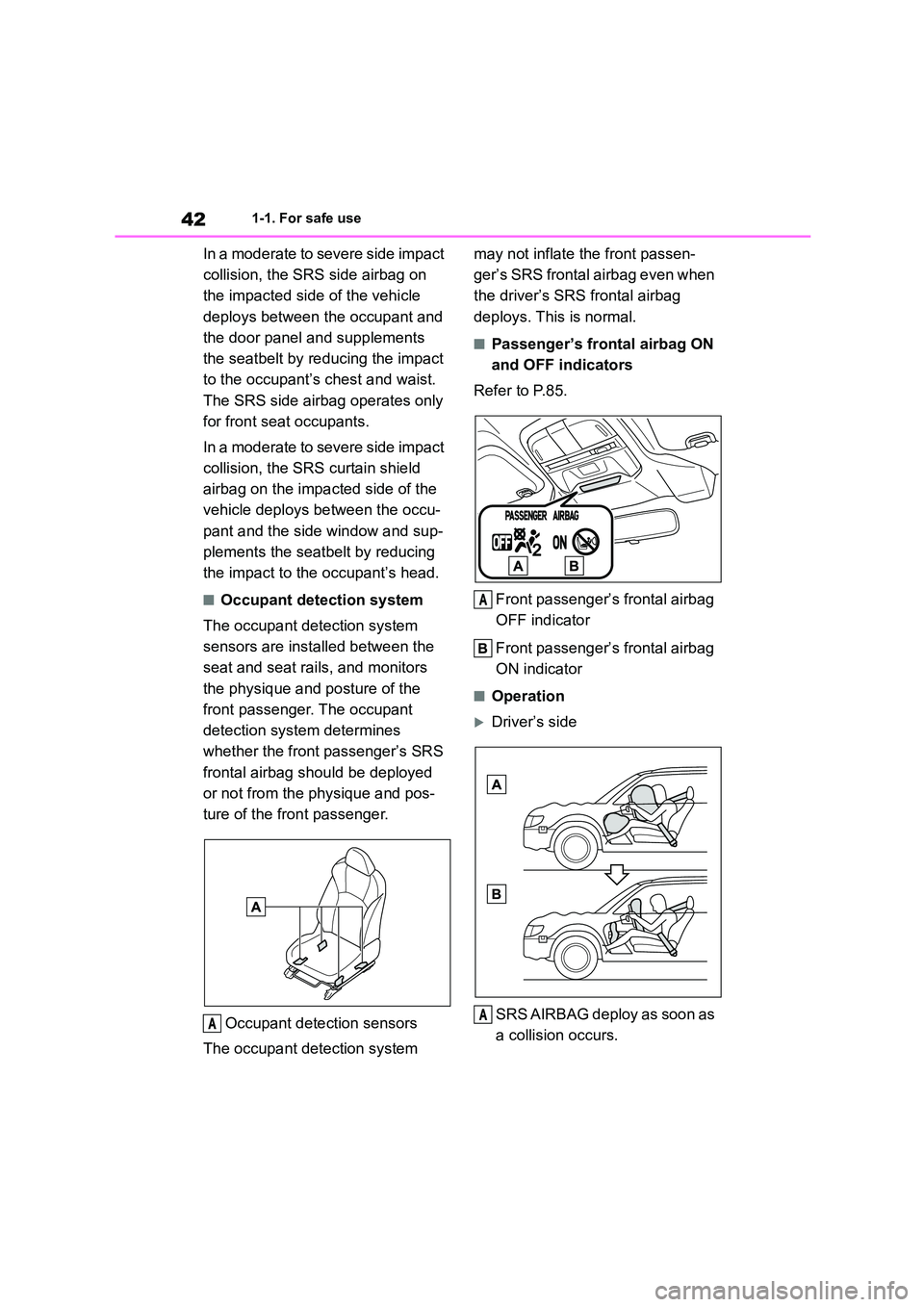
421-1. For safe use
In a moderate to severe side impact
collision, the SRS side airbag on
the impacted side of the vehicle
deploys between the occupant and
the door panel and supplements
the seatbelt by reducing the impact
to the occupant’s chest and waist.
The SRS side airbag operates only
for front seat occupants.
In a moderate to severe side impact
collision, the SRS curtain shield
airbag on the impacted side of the
vehicle deploys between the occu-
pant and the side window and sup-
plements the seatbelt by reducing
the impact to the occupant’s head.
■Occupant detection system
The occupant detection system
sensors are installed between the
seat and seat rails, and monitors
the physique and posture of the
front passenger. The occupant
detection system determines
whether the front passenger’s SRS
frontal airbag should be deployed
or not from the physique and pos-
ture of the front passenger.
Occupant detection sensors
The occupant detection system
may not inflate the front passen-
ger’s SRS frontal airbag even when
the driver’s SRS frontal airbag
deploys. This is normal.
■Passenger’s frontal airbag ON
and OFF indicators
Refer to P.85.
Front passenger’s frontal airbag
OFF indicator
Front passenger’s frontal airbag
ON indicator
■Operation
Driver’s side
SRS AIRBAG deploy as soon as
a collision occurs.A
A
A
Page 45 of 582
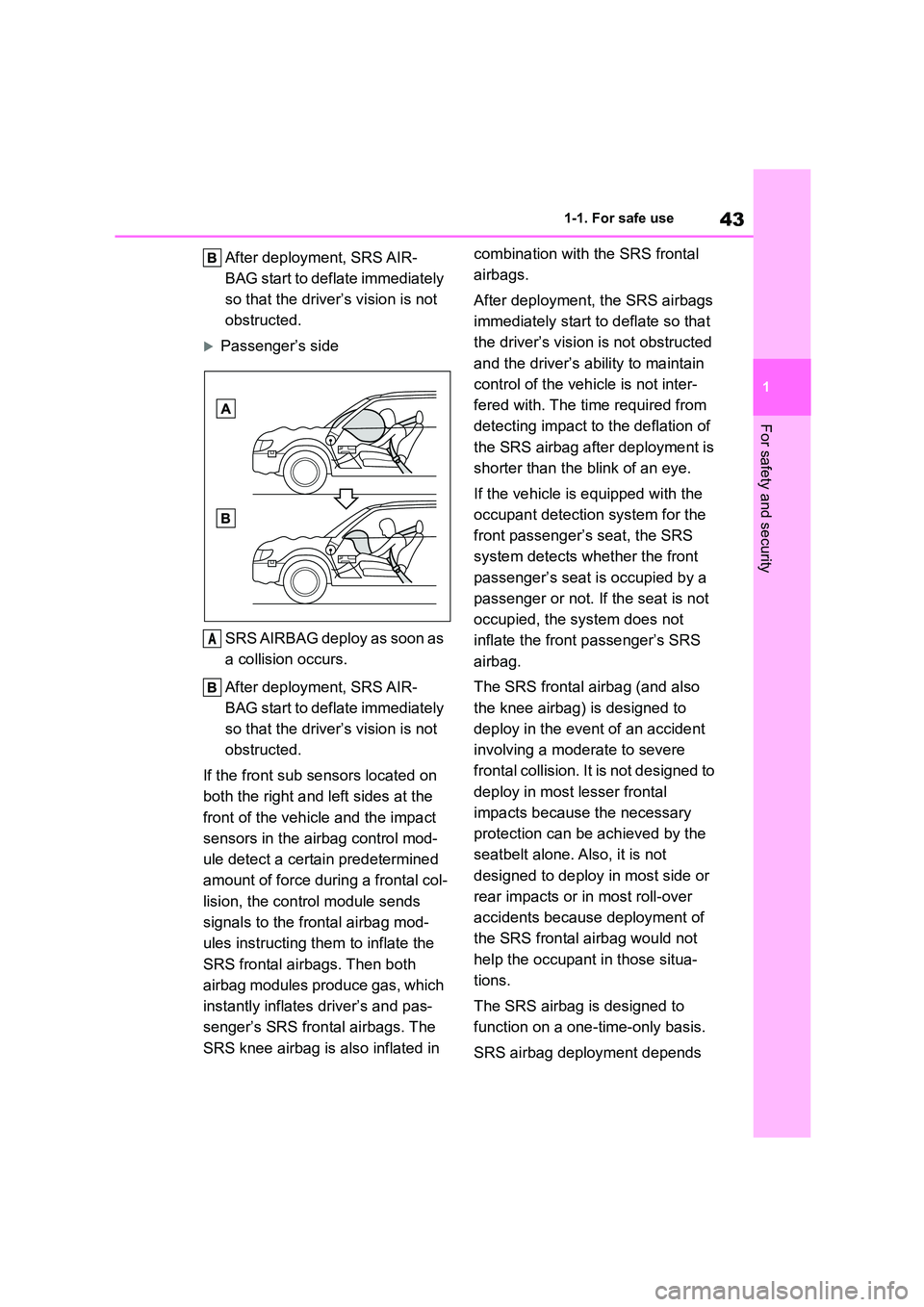
43
1
1-1. For safe use
For safety and security
After deployment, SRS AIR-
BAG start to deflate immediately
so that the driver’s vision is not
obstructed.
Passenger’s side
SRS AIRBAG deploy as soon as
a collision occurs.
After deployment, SRS AIR-
BAG start to deflate immediately
so that the driver’s vision is not
obstructed.
If the front sub sensors located on
both the right and left sides at the
front of the vehicle and the impact
sensors in the airbag control mod-
ule detect a certain predetermined
amount of force during a frontal col-
lision, the control module sends
signals to the frontal airbag mod-
ules instructing them to inflate the
SRS frontal airbags. Then both
airbag modules produce gas, which
instantly inflates driver’s and pas-
senger’s SRS frontal airbags. The
SRS knee airbag is also inflated in
combination with the SRS frontal
airbags.
After deployment, the SRS airbags
immediately start to deflate so that
the driver’s vision is not obstructed
and the driver’s ability to maintain
control of the vehicle is not inter-
fered with. The time required from
detecting impact to the deflation of
the SRS airbag after deployment is
shorter than the blink of an eye.
If the vehicle is equipped with the
occupant detection system for the
front passenger’s seat, the SRS
system detects whether the front
passenger’s seat is occupied by a
passenger or not. If the seat is not
occupied, the system does not
inflate the front passenger’s SRS
airbag.
The SRS frontal airbag (and also
the knee airbag) is designed to
deploy in the event of an accident
involving a moderate to severe
frontal collision. It is not designed to
deploy in most lesser frontal
impacts because the necessary
protection can be achieved by the
seatbelt alone. Also, it is not
designed to deploy in most side or
rear impacts or in most roll-over
accidents because deployment of
the SRS frontal airbag would not
help the occupant in those situa-
tions.
The SRS airbag is designed to
function on a one-time-only basis.
SRS airbag deployment depends
A
Page 46 of 582
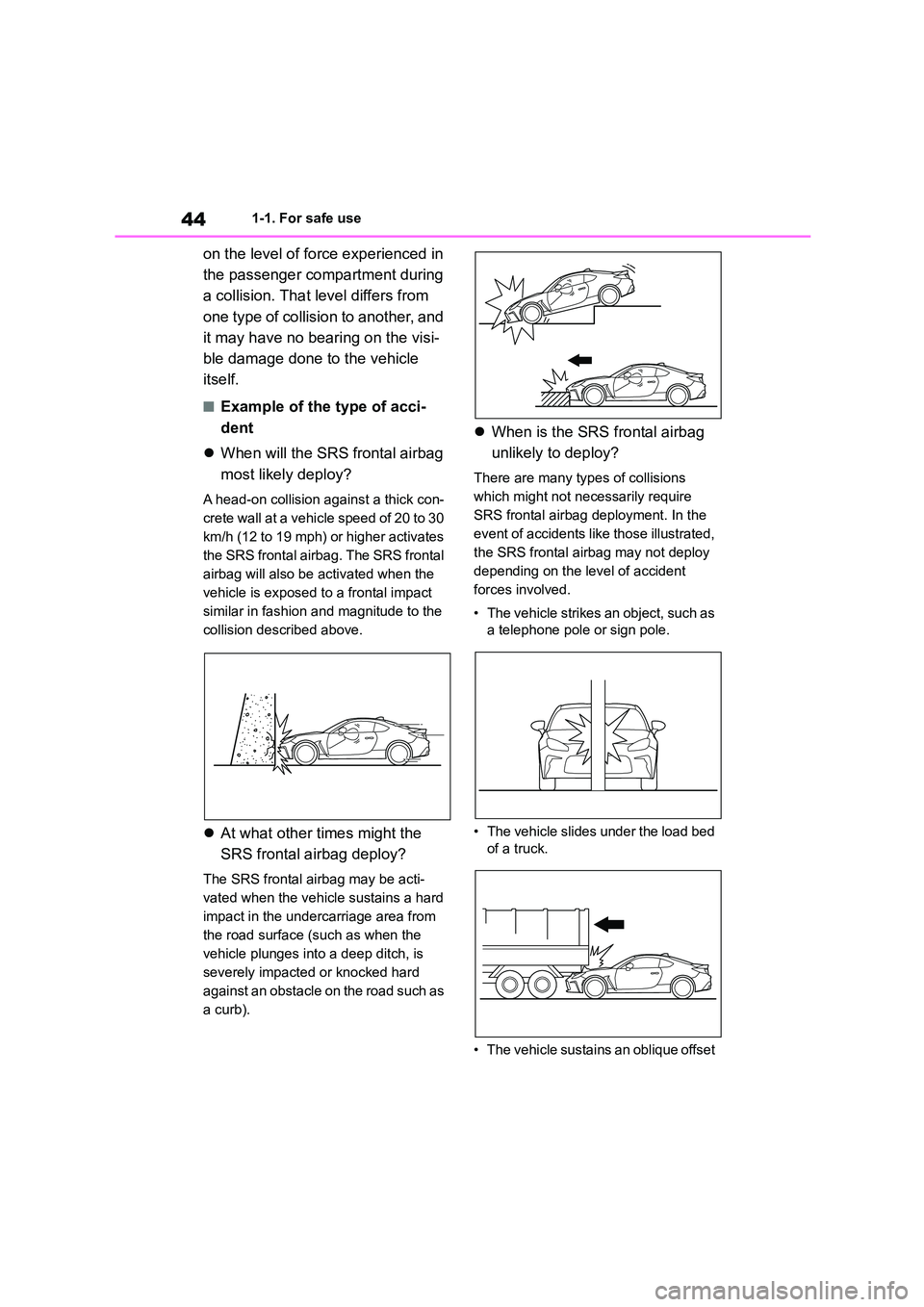
441-1. For safe use
on the level of force experienced in
the passenger compartment during
a collision. That level differs from
one type of collisio n to another, and
it may have no bearing on the visi-
ble damage done to the vehicle
itself.
■Example of the type of acci-
dent
When will the SRS frontal airbag
most likely deploy?
A head-on collision against a thick con-
crete wall at a vehicle speed of 20 to 30
km/h (12 to 19 mph) or higher activates
the SRS frontal airbag. The SRS frontal
airbag will also be activated when the
vehicle is exposed to a frontal impact
similar in fashion and magnitude to the
collision described above.
At what other times might the
SRS frontal airbag deploy?
The SRS frontal airbag may be acti-
vated when the vehicle sustains a hard
impact in the undercarriage area from
the road surface (such as when the
vehicle plunges into a deep ditch, is
severely impacted or knocked hard
against an obstacle on the road such as
a curb).
When is the SRS frontal airbag
unlikely to deploy?
There are many types of collisions
which might not necessarily require
SRS frontal airbag deployment. In the
event of accidents like those illustrated,
the SRS frontal airbag may not deploy
depending on the level of accident
forces involved.
• The vehicle strikes an object, such as
a telephone pole or sign pole.
• The vehicle slides under the load bed
of a truck.
• The vehicle sustains an oblique offset
Page 47 of 582
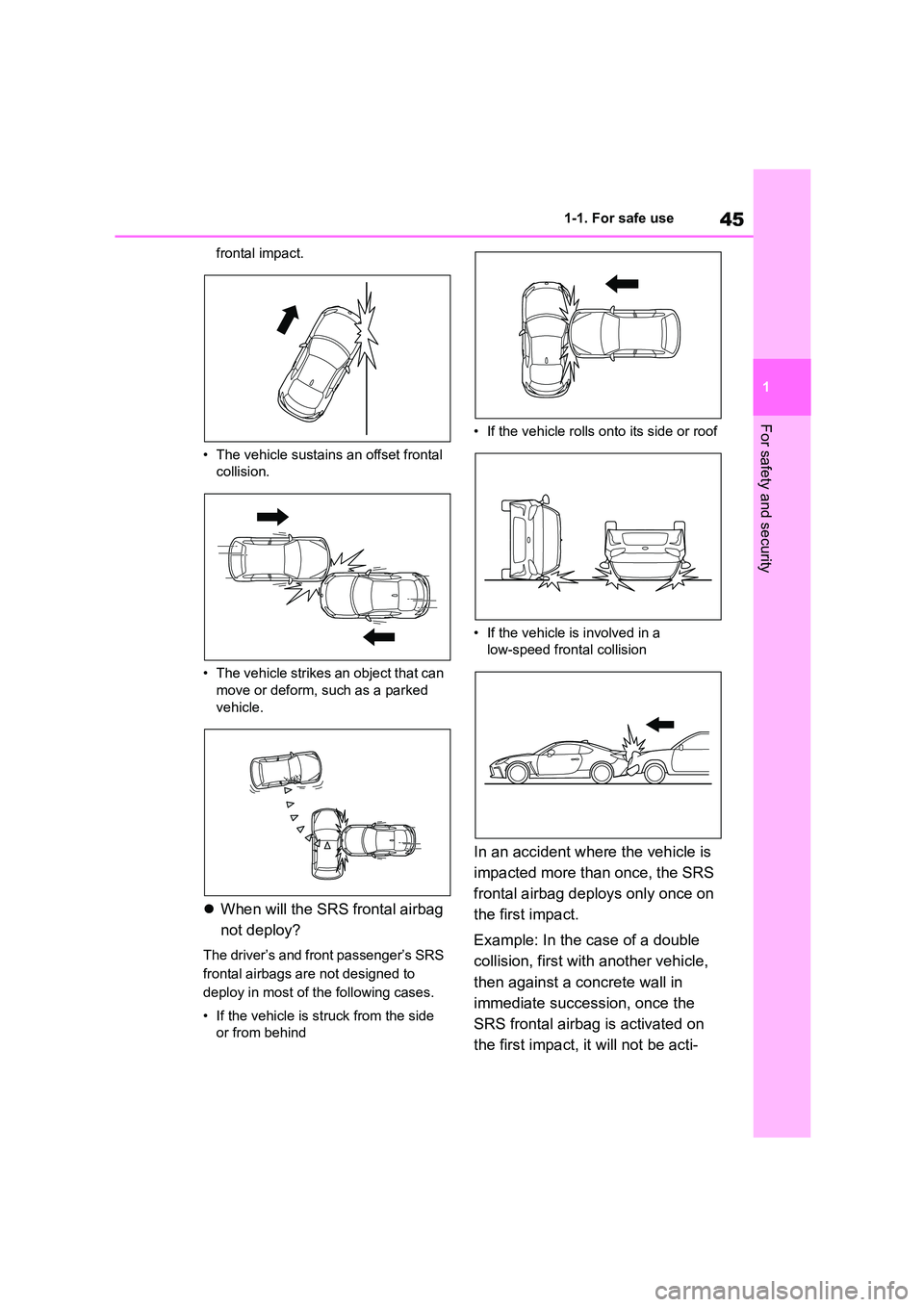
45
1
1-1. For safe use
For safety and security
frontal impact.
• The vehicle sustains an offset frontal
collision.
• The vehicle strikes an object that can
move or deform, such as a parked
vehicle.
When will the SRS frontal airbag
not deploy?
The driver’s and front passenger’s SRS
frontal airbags are not designed to
deploy in most of the following cases.
• If the vehicle is struck from the side
or from behind
• If the vehicle rolls onto its side or roof
• If the vehicle is involved in a
low-speed frontal collision
In an accident where the vehicle is
impacted more than once, the SRS
frontal airbag deploys only once on
the first impact.
Example: In the case of a double
collision, first with another vehicle,
then against a concrete wall in
immediate succession, once the
SRS frontal airbag is activated on
the first impact, it will not be acti-
Page 48 of 582
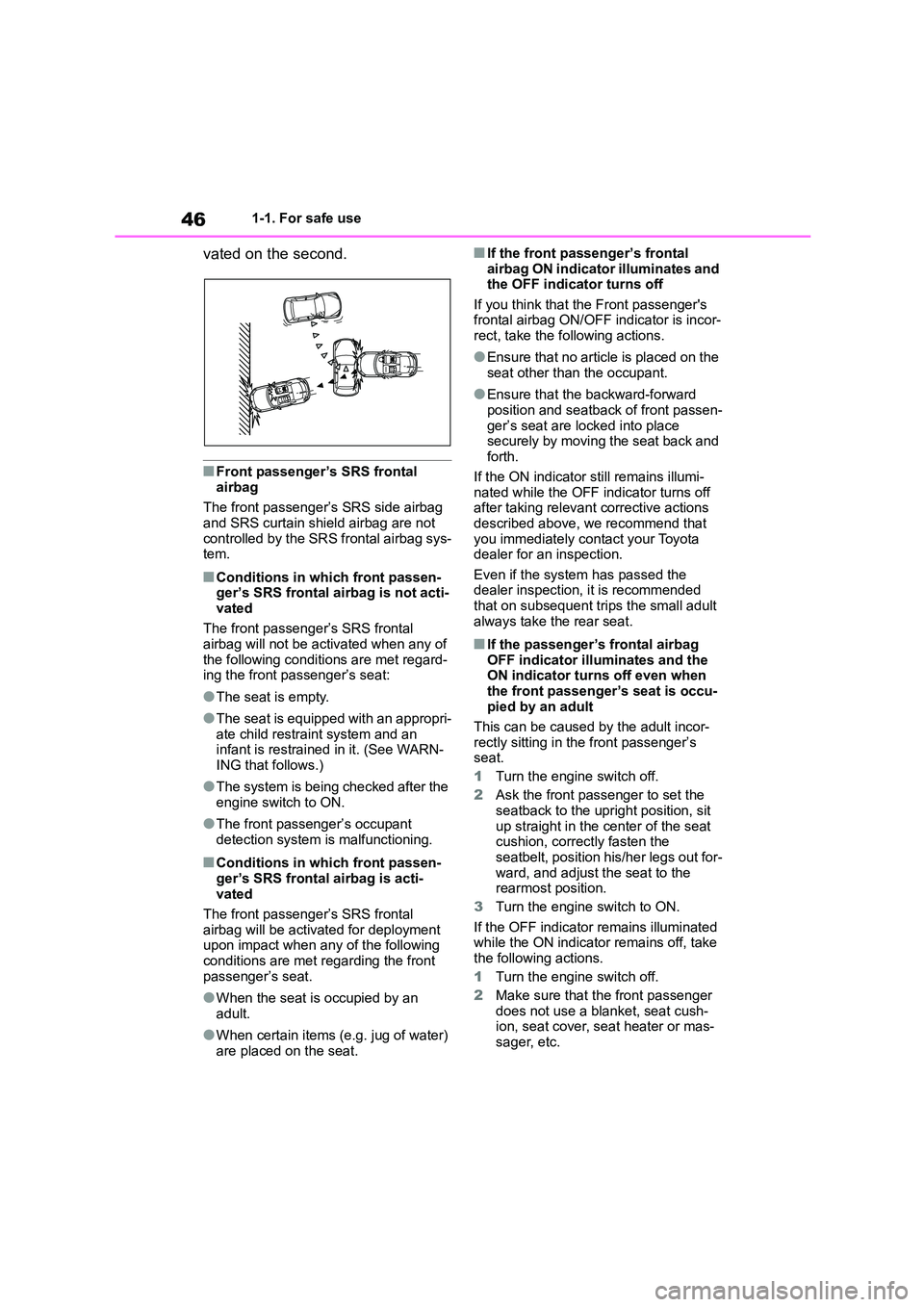
461-1. For safe use
vated on the second.
■Front passenger’s SRS frontal
airbag
The front passenger’s SRS side airbag and SRS curtain shield airbag are not
controlled by the SRS frontal airbag sys-
tem.
■Conditions in which front passen- ger’s SRS frontal ai rbag is not acti-
vated
The front passenger’s SRS frontal airbag will not be activated when any of
the following conditions are met regard-
ing the front passenger’s seat:
●The seat is empty.
●The seat is equipped with an appropri-
ate child restra int system and an
infant is restrained in it. (See WARN- ING that follows.)
●The system is being checked after the engine switch to ON.
●The front passenger’s occupant detection system is malfunctioning.
■Conditions in which front passen-
ger’s SRS frontal airbag is acti-
vated
The front passenger’s SRS frontal airbag will be activated for deployment
upon impact when any of the following
conditions are met regarding the front passenger’s seat.
●When the seat is occupied by an adult.
●When certain items (e.g. jug of water) are placed on the seat.
■If the front passenger’s frontal
airbag ON indicator illuminates and the OFF indicator turns off
If you think that the Front passenger's
frontal airbag ON/OFF indicator is incor- rect, take the following actions.
●Ensure that no article is placed on the seat other than the occupant.
●Ensure that the backward-forward position and seatback of front passen-
ger’s seat are locked into place
securely by moving the seat back and forth.
If the ON indicator still remains illumi-
nated while the OFF indicator turns off after taking relevant corrective actions
described above, we recommend that
you immediately contact your Toyota dealer for an inspection.
Even if the system has passed the
dealer inspection, it is recommended that on subsequent trips the small adult
always take the rear seat.
■If the passenger’s frontal airbag
OFF indicator illuminates and the ON indicator turn s off even when
the front passenger’s seat is occu-
pied by an adult
This can be caused by the adult incor-
rectly sitting in the front passenger’s
seat.
1 Turn the engine switch off.
2 Ask the front passenger to set the seatback to the upright position, sit
up straight in the center of the seat
cushion, correctly fasten the seatbelt, position his/her legs out for-
ward, and adjust the seat to the
rearmost position.
3 Turn the engine switch to ON.
If the OFF indicator remains illuminated while the ON indicator remains off, take
the following actions.
1 Turn the engine switch off.
2 Make sure that the front passenger
does not use a blanket, seat cush- ion, seat cover, seat heater or mas-
sager, etc.
Page 49 of 582
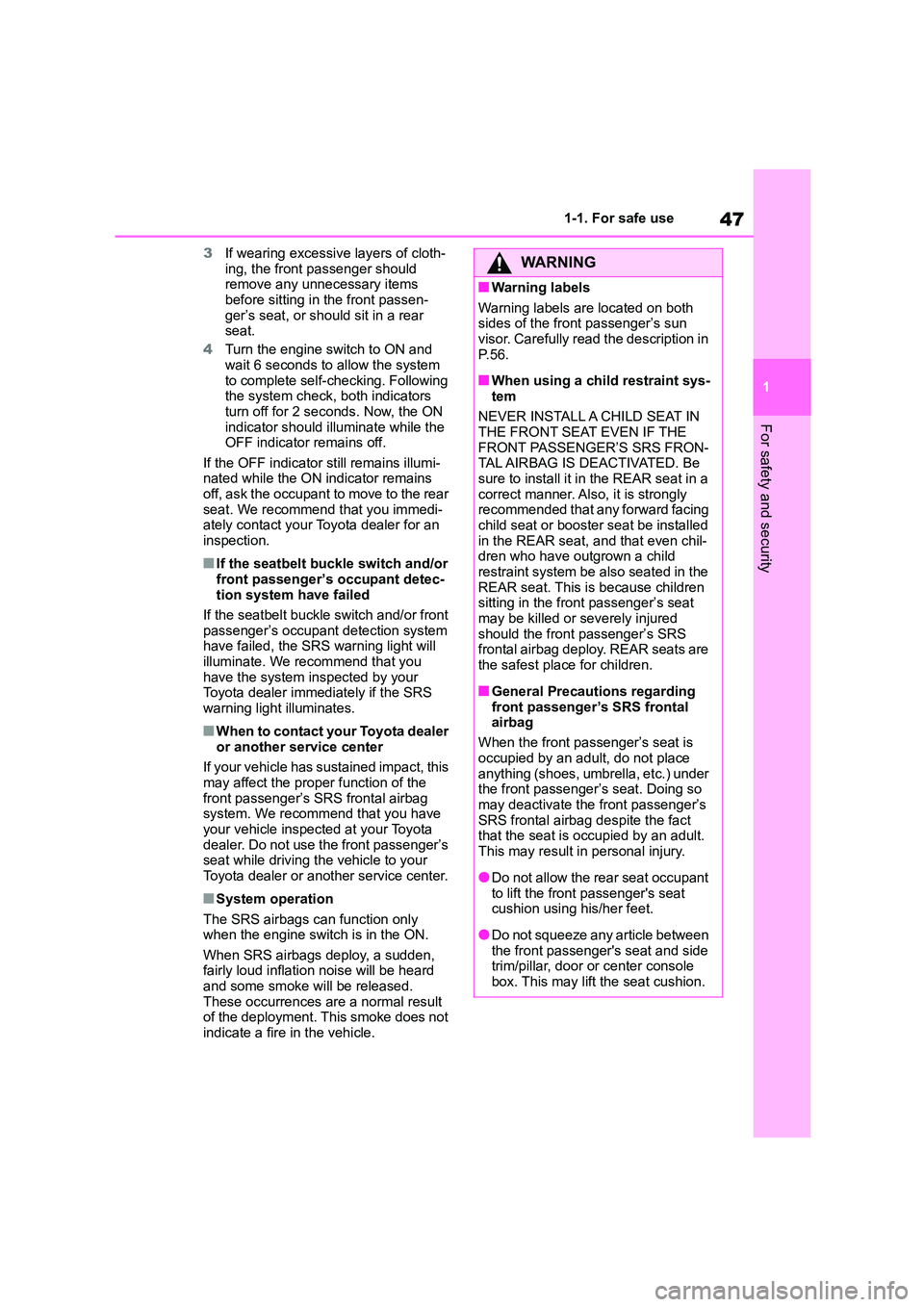
47
1
1-1. For safe use
For safety and security
3 If wearing excessive layers of cloth-
ing, the front passenger should remove any unnecessary items
before sitting in the front passen-
ger’s seat, or should sit in a rear seat.
4 Turn the engine switch to ON and
wait 6 seconds to allow the system
to complete self-checking. Following the system check, both indicators
turn off for 2 seconds. Now, the ON
indicator should illuminate while the OFF indicator remains off.
If the OFF indicator still remains illumi-
nated while the ON indicator remains off, ask the occupant to move to the rear
seat. We recommend that you immedi-
ately contact your Toyota dealer for an inspection.
■If the seatbelt buckle switch and/or
front passenger’s occupant detec-
tion system have failed
If the seatbelt buckle switch and/or front
passenger’s occupant detection system
have failed, the SRS warning light will illuminate. We recommend that you
have the system inspected by your
Toyota dealer immediately if the SRS warning light illuminates.
■When to contact your Toyota dealer
or another service center
If your vehicle has sustained impact, this may affect the proper function of the
front passenger’s SRS frontal airbag
system. We recommend that you have your vehicle inspected at your Toyota
dealer. Do not use the front passenger’s
seat while driving the vehicle to your Toyota dealer or another service center.
■System operation
The SRS airbags can function only
when the engine switch is in the ON.
When SRS airbags deploy, a sudden, fairly loud inflation noise will be heard
and some smoke will be released.
These occurrences are a normal result of the deployment. This smoke does not
indicate a fire in the vehicle.
WA R N I N G
■Warning labels
Warning labels are located on both
sides of the front passenger’s sun visor. Carefully read the description in
P.56.
■When using a child restraint sys-
tem
NEVER INSTALL A CHILD SEAT IN
THE FRONT SEAT EVEN IF THE FRONT PASSENGER’S SRS FRON-
TAL AIRBAG IS DEACTIVATED. Be
sure to install it in the REAR seat in a correct manner. Also, it is strongly
recommended that any forward facing
child seat or booster seat be installed in the REAR seat, and that even chil-
dren who have outgrown a child
restraint system be al so seated in the REAR seat. This is because children
sitting in the front passenger’s seat
may be killed or severely injured should the front passenger’s SRS
frontal airbag deploy. REAR seats are
the safest place for children.
■General Precautions regarding
front passenger’s SRS frontal airbag
When the front passenger’s seat is
occupied by an adult, do not place anything (shoes, umbrella, etc.) under
the front passenger’s seat. Doing so
may deactivate the front passenger’s SRS frontal airbag despite the fact
that the seat is occupied by an adult.
This may result in personal injury.
●Do not allow the rear seat occupant
to lift the front passenger's seat cushion using his/her feet.
●Do not squeeze any article between the front passenger's seat and side
trim/pillar, door or center console
box. This may lift the seat cushion.
Page 50 of 582
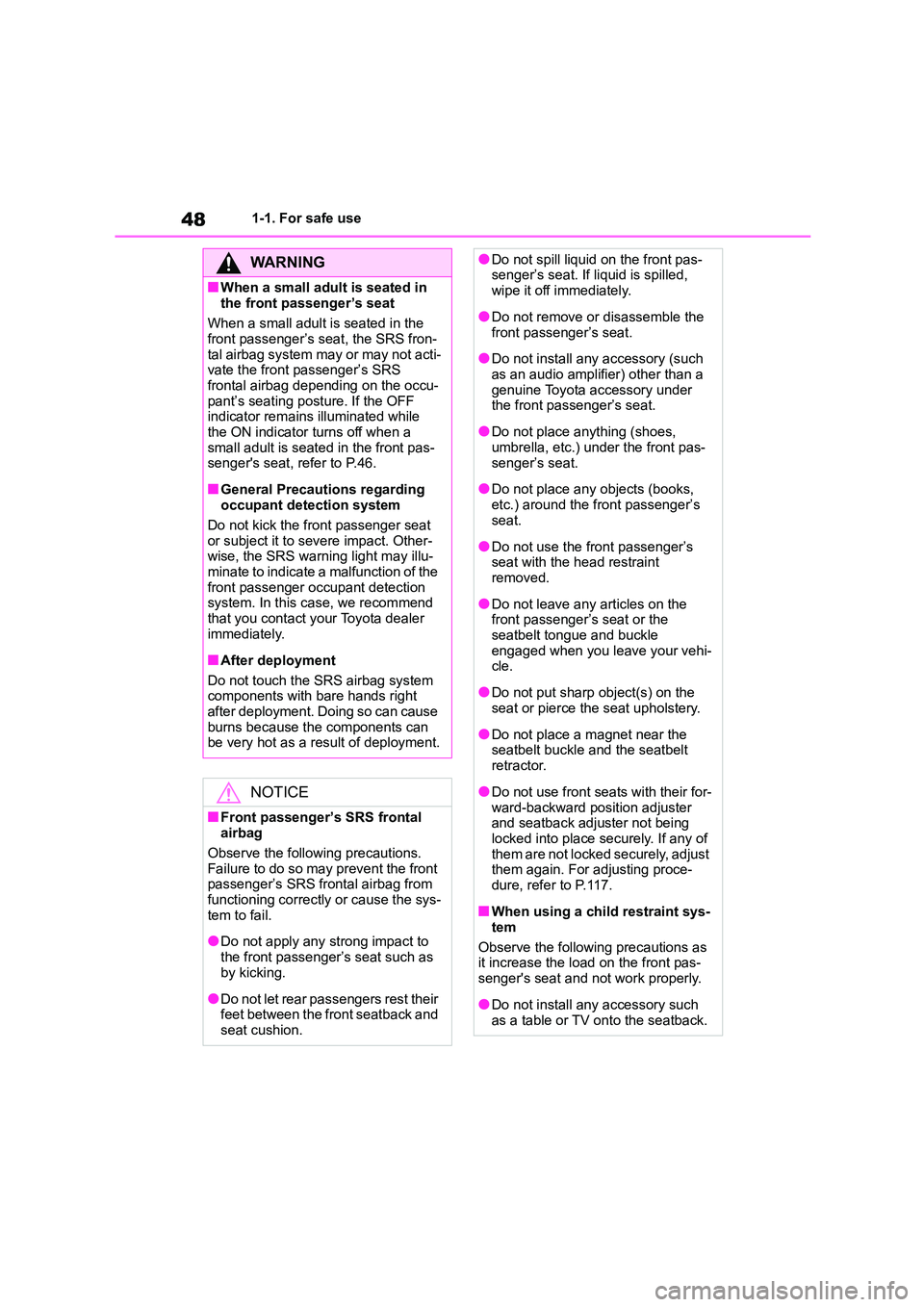
481-1. For safe use
WA R N I N G
■When a small adult is seated in
the front passenger’s seat
When a small adult is seated in the front passenger’s seat, the SRS fron-
tal airbag system may or may not acti-
vate the front passenger’s SRS frontal airbag depending on the occu-
pant’s seating posture. If the OFF
indicator remains illuminated while
the ON indicator turns off when a small adult is seated in the front pas-
senger's seat, refer to P.46.
■General Precautions regarding
occupant detection system
Do not kick the front passenger seat or subject it to severe impact. Other-
wise, the SRS warning light may illu-
minate to indicate a malfunction of the front passenger occupant detection
system. In this case, we recommend
that you contact your Toyota dealer immediately.
■After deployment
Do not touch the SRS airbag system
components with bare hands right
after deployment. Doing so can cause burns because the components can
be very hot as a result of deployment.
NOTICE
■Front passenger’s SRS frontal
airbag
Observe the following precautions.
Failure to do so may prevent the front
passenger’s SRS frontal airbag from functioning co rrectly or cause the sys-
tem to fail.
●Do not apply any strong impact to
the front passenger’s seat such as
by kicking.
●Do not let rear passengers rest their
feet between the front seatback and seat cushion.
●Do not spill liquid on the front pas-senger’s seat. If liquid is spilled,
wipe it off immediately.
●Do not remove or disassemble the
front passenger’s seat.
●Do not install any accessory (such
as an audio amplifier) other than a
genuine Toyota accessory under the front passenger’s seat.
●Do not place anything (shoes, umbrella, etc.) under the front pas-
senger’s seat.
●Do not place any objects (books,
etc.) around the front passenger’s
seat.
●Do not use the front passenger’s
seat with the head restraint removed.
●Do not leave any articles on the front passenger’s seat or the
seatbelt tongue and buckle
engaged when you leave your vehi- cle.
●Do not put sharp object(s) on the seat or pierce the seat upholstery.
●Do not place a magnet near the seatbelt buckle and the seatbelt
retractor.
●Do not use front seats with their for-
ward-backward position adjuster
and seatback adjuster not being locked into place securely. If any of
them are not locked securely, adjust
them again. For adjusting proce- dure, refer to P.117.
■When using a child restraint sys-
tem
Observe the following precautions as
it increase the load on the front pas-
senger's seat and not work properly.
●Do not install any accessory such
as a table or TV onto the seatback.